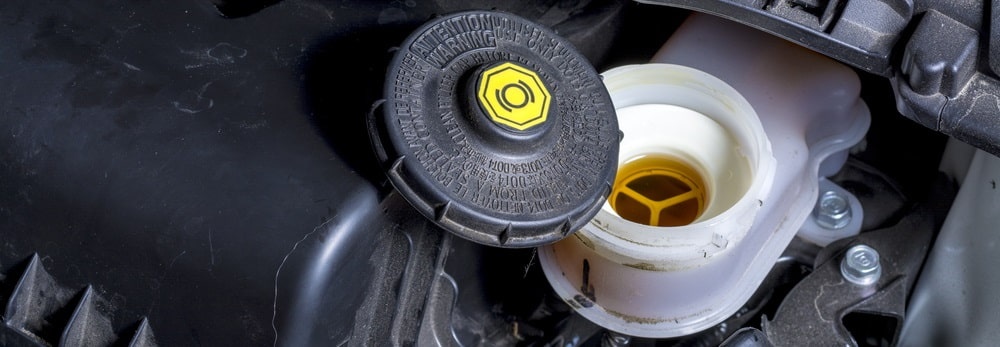
10 Steps on How to Check and Add Brake Fluid Like a Pro
Brake fluids are primarily used in braking and clutch systems. Typical applications include cars, light trucks, and motorcycles. With more than 263 million vehicles on the roads daily, the braking system is crucial for driver safety.
Your car’s owner manual will give details on certain time-based/mileage-based service that should be done, including oil, transmission, coolant, and different fluid changes. Still, most U.S. manuals offer no guidelines for when to service the brake fluid (brake oil).
So, what do you have to look for when checking brake fluid? Here’s a brake repair guide that will explain everything about this topic.
What is Brake Fluid?
It’s a sort of hydraulic fluid used in brake systems to help the movement of the brake pedal to start the brake pads at the wheels and stopping your car. Also, brake oil is a lubricant and anti-corrosion fluid that aids to ensure that your vehicle’s brake system works optimally.
What Does Brake Fluid Do?
It works in conjunction with your car’s hydraulic system. The master cylinder needs fluid to put pressure in the brake line, making it move. The fluid’s pressure triggers the mechanical brakes (the pads, discs, and caliper), which put pressure on the wheel, causing it to stop. The vehicle won’t work correctly without brake fluid.
What Do DOT Ratings Mean?
All forms of braking oil are given a DOT rating. DOT stands for the Department of Transport, which sets the safety regulations for the acceptable performance of different brake fluids. These ratings given to brake fluids are based on the liquid’s wet and dry boiling points. As a general rule, the higher the boiling point, the longer the lifespan of the brake fluid.
Types
The four main types of brake fluid now available are DOT3, DOT4, DOT5, and DOT 5.1. DOT3, DOT4, and DOT 5.1 are glycol-based fluids, while DOT5 is silicon-based. The main difference is that DOT3, DOT4, and DOT 5.1 absorb water, while DOT5 doesn’t.
Two other essential things about brake oil: DOT3 and DOT4 eat paint, so don’t spill either of these on your vehicle. Also, none of the different sorts of brake oil should be combined. They can respond badly to each other and destroy the brake system.
Key Features
- Boiling point – A braking system generates high temperatures. If the temp gets too high, it warms up the brake fluid and can make vapor in the brake lines, forming a drop in braking ability. The dry boiling point refers to the new fluid. If the oil has been in use for a while, the boiling point falls thanks to water contamination. The wet boiling point refers to the oil that has been in use for some time and includes a certain amount of moisture mixed in;
- Compatibility – Certain brake fluids are designed for specific brake systems, such as drum brakes or disc brakes. Others are made for different systems. It must be compatible with your particular car to work correctly and prevent brake failure;
- Viscosity – A vehicle’s brake oil should maintain its thickness throughout many operating temperatures. It’ll ensure that the traction/stability control, and anti-lock braking system function adequately. As a result, it’s critical to prescribe to a viscosity recommended by the manufacturer. Generally, DOT 5.1 brake fluids have the lowest viscosity over a wide range of temps;
- Corrosion resistance – Brake fluids repel corrosion in areas including wheel cylinders, master cylinders, calipers, and ABS control valves. Manufacturers utilize various additives in their products against corrosion. Some forms of brake fluids are more corrosive than others. For instance, silicone is less corrosive than glycol-ether-based products.
Benefits
- Safety – If your brake fluid is old and worn, it won’t work properly. It means your vehicle will take more to stop, which can lead to an accident that can harm you or others;
- Prevents brake failure – If you don’t use the right brake fluid, your machine won’t operate correctly. It’s an integral part of your braking system, which depends on the substance for stopping power;
- Increases performance – If you race your ride on the track or run autocross, reliable brakes are pivotal. The high-quality braking oil will give you more stopping power than lower-quality products.

How to Check Brake Fluid Level
It’s recommended to check the condition of the brake oil every 6,000 miles. As a rule of thumb, brake fluid should be replaced every 30,000 miles or every two years.
Your car’s service manual will give you more accurate information about how frequently the braking oil should be checked/changed and what type of fluid should be used.
Read the following procedures and learn how to check your brake fluid level.
- Park the car in the level area – Ensure the vehicle is stationary and on a level surface. Letting the vehicle to move or having it at steep pitch can make the fluid levels read incorrectly;
- Press the brake pedal 20 to 30 times – Some manufacturers specify that this be done if the vehicle has ABS;
- Locate the brake oil reservoir – It’s usually located under the hood, on the driver’s side of the car, against the back of the engine compartment or near the base of the windshield;
- Check the brake fluid level – Most modern cars have a plastic reservoir that’s transparent and has MIN and MAX marks on it. If yours is this kind, you should be able to see if the braking oil is between these grades.
RELATED ARTICLES:
- 13 Top-Rated Electric Vehicles in the USA
- 12 Best Luxury SUVs in the Showroom
- 13 Best Off-Road Vehicles for Safari
- Best Midsize SUV – 11 Most Powerful Machines
- Best Used SUV – 13 Budget Surfers for Any Family
- 10 Best 3 Row SUVs for City and Highway
- Top 13 Hybrid Cars on the Market
- Car Detailing 101
- Auto Insurance – All You Have to Know
- 15 Best Hatchbacks for the Narrowest Avenues in the Town
Testing Brake Fluids
The FMVSS (Federal Motor Vehicle Safety Standards) No.116 stipulates the requirements for car brake fluids. To be considered one of the DOT classifications, the brake fluid must go through the following tests:
- Resistance to oxidation;
- pH value;
- Kinematic viscosities;
- High temperature and chemical stability);
- Stroking properties;
- Effects on cups;
- Reserved;
- Corrosion;
- Fluid color;
- Wet equilibrium reflex boiling point (tested with 3.7% water);
- Equilibrium reflux boiling point (dry boiling point);
- Compatibility (low temperature and at 140 degrees F);
- Water tolerance (low temperature and at 140 degrees F);
- Fluidity and appearance at low temperatures.
What Happens When Brake Fluid Is Low?
When you have low braking oil, it can have an effect on your brake pads. Brake pads are essential to your vehicle’s braking system, so having a low level can cause brake pads to not work as they should.

How to Put Brake Fluid in a Car
One of the most critical car components to check is the brake oil, which has a crucial role in keeping your brakes functional.
Here are 6 steps on how to add brake fluid in your vehicle.
- Required tools – Braking oil (vehicle specified) and latex/nitrile gloves;
- Inspect the fluid color – It becomes contaminated during regular use. Clean fluid a has golden yellow color, while dirty fluid becomes dark amber in color;
- Remove the cap – If your fluid level is below the minimum level, or you can’t see your braking oil grade with the cap on, you have to carefully remove the lid;
- Clean the reservoir – Use a clean rag and wipe all the dirt/grease away from the cap and the reservoir’s top;
- Adding brake fluid – Slowly put it to the reservoir until it’s at the desired grade. Make sure to add the correct fluid for your car;
- Replace the cap – If the braking oil color and level are both acceptable, you’re finished with the brake fluid check, and now you can replace the lid on the reservoir.
How Often to Change Brake Oil
During the time, brake fluid (hygroscopic), so it absorbs moisture from the air, which will cause the oil to degrade and not work adequately. Therefore, it’s crucial to periodically drain the oil fluid and replace it with new fluid to ensure proper operation.
Most professionals suggest changing the fluid for brakes every one to two years, but every car has different maintenance needs. Since its mission is so integral to safety, check your owner’s manual for the recommended braking oil changing schedule.
What Happens if Brake Fluid Isn’t Changed?
When you fail to change the brake oil, it automatically absorbs moisture from the environment. Moisture-loaded fluid can cause corrosion and rust of the metal parts. These results in rust particles getting to brake fluid, making it contaminated. Forgetting to change the brake fluids will affect the functioning of a car’s brake system.
What Brake Fluid do I Need?
As we said, there are glycol-based and silicone-based brake fluids. Silicone-based fluids are for cars without ABS. Therefore, check your owner’s manual to determine which product will meet your needs.
What are the Most Common Braking Oil Issues?
Traditionally, brake fluid issues occurred when moisture (again) seeped into the brake fluid, but the service problems with fluid today are different than 20-30 years ago. In fact, moisture in brake oil today isn’t much of a service issue since modern construction methods of flexible brake hoses have eliminated most moisture intrusion problems.
In 2020, brake fluid can be accurately tested to determine replacement needs. This’s because the most common issues stem from the levels of dissolved copper and depleted additive package in braking oils. The level of dissolved copper in brake oil is a sign of the health of the brake fluid’s additive pack. When the additive package of braking oil is used up – one of the negative incomes may be sludge build-up and/or internal brake system component corrosion.

Checking for Leaks
There are a few reasons why you have low brake oil in the vehicle. One of them is normal wear and tear, as the pads or shoes wear down in your brakes, the fluid level will fail. The other reason is external fluid leaks, so whenever you’re inspecting your fluid level or condition, you should have a look for any signs of leakage, too.
The most common area for leakage is at the back of the master cylinder, where it joins to the brake booster. Common indicators to look for are stains and paint peeling and/or bubbling as if the fluid has leaked onto a painted surface, it’ll ruin the paint.
Verdict
Remember, braking oil is what is between your brake pedal and the brakes at all four wheels. Make brake oil a part of your regular maintenance routine, and replace it when necessary to keep you and your passengers safe.
